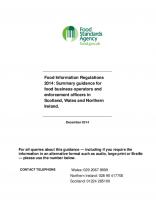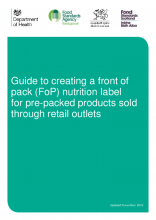Food information regulations
On this page
- The Food Information Regulations and EU Food Information for Consumer Regulations (EU FIC)
- Compliance dates
- The essentials
- Main changes
- Irradiated foods
- Additives
- The name of a food
- Additional changes affecting pre-packed food
- Field of vision requirements
- Distance selling requirements
- Commercial selling
- Language
- Name of the food
- Name of the business
- Country of origin
- Freezing
- Minced meat
- Animal/vegetable fats and oils
- What do I need to do?
- Further guidance
The Food Information Regulations and EU Food Information for Consumer Regulations (EU FIC)
The Food Labelling Regulations 1996 have been replaced by the EU Food Information Regulation 1169/2001 (FIR). This legislation came into force on 13 December 2011.
The main requirements are detailed in the Food Information Regulations 2014 and this includes an annex covering general and more specific changes to nutrition labelling which are covered in the Food Information for Consumer Regulations (FIC).
These new regulations apply to all food businesses supplying food to the public and caterers, including retail premises, manufacturers, restaurants, delicatessens, bakeries, sandwich bars, supermarkets, caterers, take-aways, buffets, and home caterers. There are some exemptions for example private individuals providing food for events such as church, village or school fetes where there is no food business element.
Compliance dates
- 1 January 2014 – For the rules on the composition and labelling of minced meat
- 13 December 2014 – For the general labelling rules, and if provided, a nutrition declaration must use the format set out in the EU FIC from this date
- 13 December 2016 – For the rules on the mandatory nutrition declaration needed for most pre-packaged foods
The essentials
Much of what is detailed in the current Food Labelling Regulations 1996 remains unchanged. There is no change in the fundamental principles of providing safe food which is honestly described and not misleading. In addition foods cannot be labelled to state they will prevent, treat or cure a human disease. The following information must be required in English on prepacked food labelling:
- A true name or description of the food
- The ingredients it contains, in descending weight order
- How it should be handled, stored, cooked or prepared
- Who manufactured, packed or imported it
- Origin information if its absence would mislead
- Allergenic ingredients identified on the label
- Specific information declaring whether the food is irradiated or contains genetically modified material or aspartame, high caffeine, sweeteners, packaging gases etc
- Net quantity in grams, kilograms, litres etc
- Alcoholic strength where there is more than 1.2% alcohol by volume
Main changes
Allergens
Businesses will need to provide information if any of the foods/ingredients detailed in the EU Regulations and indicated below are used in the preparation of food they supply. This information can be provided on labels, shelf-edge, menus or verbally if requested by the customer.
The 14 ingredients or products thereof causing allergies or intolerances are: Cereals containing gluten (wheat, rye, barley, oats, spelt, kamut), Crustaceans, Molluscs, Eggs, Fish, Peanuts, Soybeans, milk (including lactose), Nuts, Celery, Mustard, Sesame Seeds, Lupin and Sulphur Dioxide and Sulphites (at concentrations of more than 10mg/kg) |
If the food is non-pre-packed such as in a restaurant or café then the information about allergens can be supplied on the menu, on chalk boards, tickets or provided verbally by an appropriate member of staff as well as in other formats made available to the consumer. It must be clear and conspicuous, not hidden away, easily visible, and legible. If the information is to be provided verbally by a member of staff then it is necessary to make it clear that the information can be obtained by asking a member of staff by means of a notice, menu, ticket or label that can easily be seen by customers.
Allergen information must be specific to the food, complete and accurate. This also applies to foods prepacked for direct sale such as from deli counters or sandwich bars.
Refusal to give information, inaccurate or incomplete information about allergenic ingredients used in foods sold non-prepacked or pre-packed for direct sale would be a breach of the EU Food Information for Consumers Regulations.
Irradiated foods
Foods that are treated with ionising radiation must be labelled with the words ‘irradiated’ or ‘treated with ionising radiation’ as stated in Directive 1999/2/EC. Where an irradiated product is used as an ingredient in another product, the same words must accompany its designation in the list of ingredients.
Additives
Food additives (and enzymes) which are used as processing aids do not generally have to be listed as ingredients.
The name of a food
The name of the food is not required under the European legislation but may be required by UK provisions. Where there is a name laid down by law this must be used. If not, a customary name may be used. If there is no customary name, or it is not used, a descriptive name must be used. The name of a food may consist of a name, a description, or both.
Additional changes affecting pre-packed food
Allergen labelling for pre-packed food
Allergens listed in the EU Food Information for Consumers Regulations 1169/2011 must be declared in the ingredients list on prepacked food and emphasised through a different font, style etc. If it is not obvious from the name of the ingredient, there needs to be a clear reference to the name of the allergen next to it. E.g. stock (from fish)’, couscous (wheat)’, ‘tahini (sesame)’, casein (milk), and tofu (soya)
Allergen ingredients must not be repeated elsewhere on the labelling, however sign posting to the allergen information within the ingredients list is allowed. For example, the use of ‘Contains’: followed by a list of allergens will no longer be permitted. Voluntary statements highlighting the risk of cross contamination with allergens may still be used.
Example of a label indicating ingredients and allergens:
Ingredients: Figs (35%), barley, flakes, toasted and malted oat flakes (oat flakes, barley malt extract), toasted and malted wheat flakes (wheat, barley malt extract), nuts (8%) (brazil nuts, whole hazelnuts) oat flakes, wheat flakes, sunflower seeds (2%) |
! allergy advice Please see ingredients for allergens. May contain other nuts and milk |
Nutritional labelling
From 13 December 2016 all prepacked food must be labelled with nutrition information which must be in a set prescribed format (commonly referred to as “back of pack” or “traffic light “nutrition labelling). This comprises energy values (in kilojoules (Kj) and kilocalories (kcal)) plus the amounts (in grams (g)) of fat, saturates, carbohydrate, sugars, protein and salt.
Previously nutritional information was only required where a claim was made such as ‘low in fat’.
Even if you already provide this information you may need to amend your labelling as the legislation requires this information to be provided in a prescribed order and the salt content is now required rather than sodium.
There are some exceptions and specific requirements and these are detailed in the Annex of The Food Information Regulations 2014.
Field of vision requirements
A minimum font size has been set for all mandatory information; the height of the letter ‘x’ in the chosen font must not be less than 1.2mm.
The field of vision requirements no longer include durability. Only the name of the food, net quantity and alcoholic volume need to be able to be read by the consumer from a single view point.
Distance selling requirements
All mandatory information must be provided both before the purchase is concluded (except for durability date) and at delivery and at no additional cost. So if a Food Business Operator (FBO) is making the information available through a telephone helpline then this number must be a free-phone line.
Commercial selling
Formerly food supplied between some businesses was exempt from labelling requirements. However, now everyone in the supply chain must ensure mandatory information is available on the food labelling or on documents such as invoices so that those further down the supply chain can meet their obligations.
Language
Food information must be given in English, however, it can also be provided in other languages.
Name of the food
Where there is a name laid down by law this must be used. If not a customary name may be used. If there is no customary name, or it is not used, a descriptive name must be used. The name of a food may consist of a name, a description or both. In the case of some foods, there are compulsory product names that must be used for foods meeting certain composition criteria.
The name of food has always needed to include a reference to the physical condition or treatment the food has undergone such as ‘powered’, ‘dried’, ‘smoked’, ‘concentrated’ etc. This has now been extended to include an indication if the food has been defrosted.
The word ‘formed’ must be used when meat or fish products have been made from different pieces of meat and yet have the appearance of a whole piece of meat.
Name of the business
The FBO whose name appears on the labelling is the business responsible for the information on the label. This must be a FBO in the EU or, where the food is imported into the EU, the importer into the EU.
Country of origin
Some of the origin labelling provisions have yet to be agreed. These will be subject to the Commission report.
The origin or place of provenance of a food must be given if it misleads consumers by its absence.
County of origin labelling has now been extended to the meat of pigs, sheep, goats and poultry. Beef, fish, honey, olive oil, fresh fruit and vegetables already require this.
Freezing
The date of first freezing is required on meat and fishery products.
Minced meat
European compositional standards and additional labelling requirements are required for prepacked minced meat. If you are selling only in the UK different rules apply and a ‘national’ mark must be used. This was a requirement from 1 January 2014.
Animal/vegetable fats and oils
The source of any animal or vegetable oil or fat ingredient must be provided and displayed in the ingredients list e.g., palm oil, beef fat. If hydrogenated fats are used a full description must be used such as ‘fully or partly hydrogenated.’
What do I need to do?
As a Food Business Operator you need to know how the legislation will affect your business and you need to start making plans now so that you comply in time.
Detailed food labelling legislation information can be found on the European Commission website.
Further guidance
Last updated: 29 November 2019


